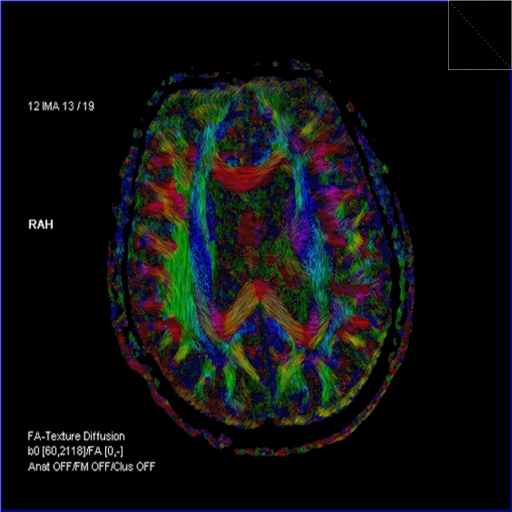Traumatic Brain Injury (TBI)
Concussions, Traumatic Brain Injuries, and even minor head injuries can be extremely debilitating, especially when the brain MRI comes back normal. Diffusion Tensor Imaging (DTI) is a powerful brain imaging tool that evaluates the fiber tracts in the brain that can’t be seen on a traditional MRI.
It can also provide precise number values that can help determine the severity of injury. In sports, this number can help athletes understand more about concussion and provide baseline information if a future injury every occurs. Diffusion tensor imaging can provide an index of white matter integrity in traumatic brain injury as well as a potential biomarker reflective of outcome.

Treatments for Head Injuries
Given the nature of the injury and the population examined, up to 90% of patients who experience a concussion can develop postconcussive syndrome (PCS). This syndrome can consist of a persistence of any combination of the following symptoms after a head injury: headache, nausea, emesis, memory loss, dizziness, blurred vision, emotional lability, or sleep disturbances.
Treatments for head injuries will vary depending on the severity of the injury or concussion, including factors such as the type of injury, loss of conscientiousness and the treating physician. Injuries that are un-diagnosed may cause long-term disability and impairment. The utilization of DTI can greatly increase the visualization of these injuries and can provide specific individualized data to determine the severity of an injury to aide in the treatment process.
Sources:
1. Postconcussion Syndrome. Eric L Legome, MD, Trevor John Mills, MD, MPH; Medscape, Dec 06, 2017
2. White matter fiber tracts of the human brain: three-dimensional mapping at microscopic resolution, topography and intersubject variability. Bürgel U, Amunts K, Hoemke L, Mohlberg H, Gilsbach JM, Zilles K.; Neuroimage. 2006 Feb 15;29(4):1092-105. Epub 2005 Oct 19.
3. Subject-specific changes in brain white matter on diffusion tensor imaging after sports-related concussion. Jeffrey J. Bazarian, Tong Zhu, Brian Blyth, Allyson Borrino, Jianhui Zhong; Magn Reson Imaging. 2012 Feb;30(2):171-80. doi: 10.1016/j.mri.2011.10.001. Epub 2011 Nov 12.
4. Serial measurement of memory and diffusion tensor imaging changes within the first week following uncomplicated mild traumatic brain injury. Elisabeth A. Wilde, Stephen R. McCauley, Amanda Barnes, Trevor C. Wu, Zili Chu, Jill V. Hunter, Erin D. Bigler; Brain Imaging and Behavior (2012) 6: 319.
5. Longitudinal diffusion tensor imaging and neuropsychological correlates in traumatic brain injury patients. Kimberly D. Farbota, Barbara B. Bendlin, Andrew L. Alexander, Howard A. Rowley, Robert J. Dempsey, Sterling C. Johnson; Front. Hum. Neurosci., 19 June 2012
6. Diffusion Tensor Imaging Analysis of Frontal Lobes in Pediatric Traumatic Brain Injury. Margaret B. Oni, MD, Elisabeth A. Wilde, PhD, Erin D. Bigler, PhD Stephen R. McCauley, PhD, Trevor C. Wu, Ragini Yallampalli, Zili Chu, PhD, Xiaoqi Li, MS, Jill V. Hunter, MD, Ana C. Vasquez, Harvey S. Levin, PhD; Journal of Child Neurology, March 23, 2010

